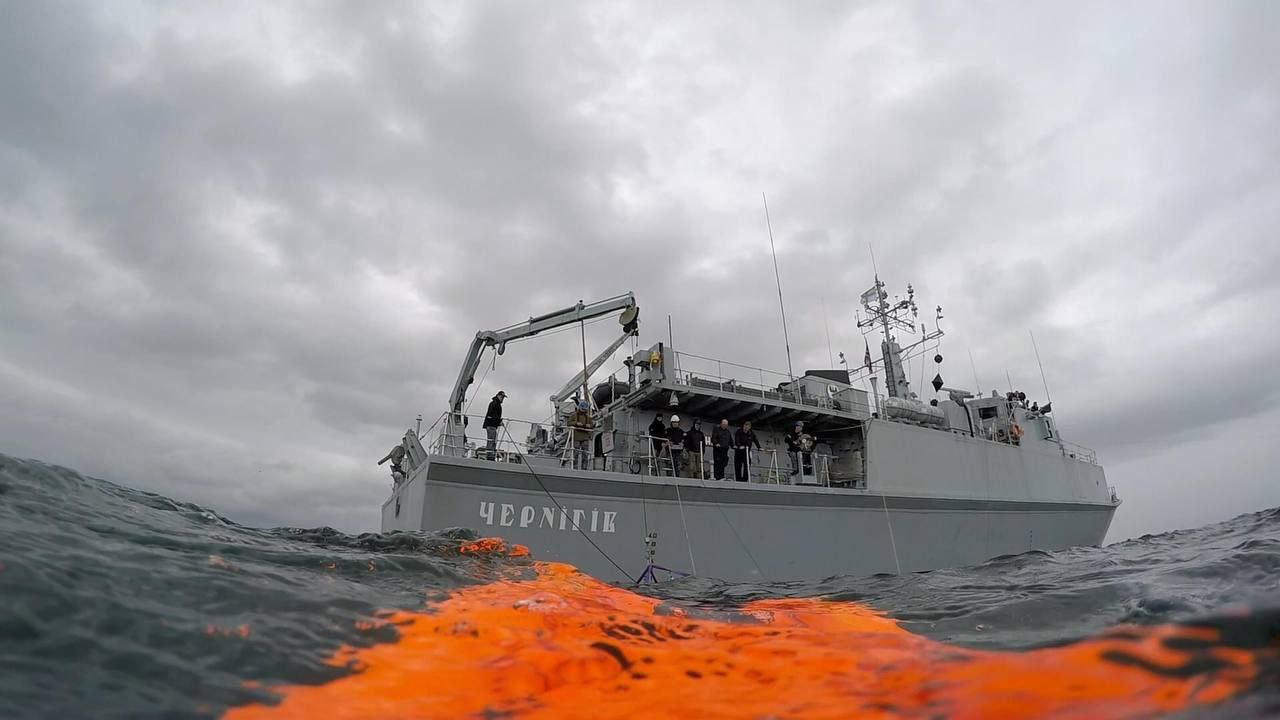According to photos on social media, Ukrainian navy personnel are training with unmanned underwater minesweeper drones on a former Royal Navy vessel. The goal is to demine the seas around Ukraine’s Black Sea ports which Kyiv says have been heavily mined by Russia, limiting grain shipments and agricultural trade.
The unmanned underwater vehicle (UUV) in question is the SeaFox-I used by the Royal Navy, while the minesweeper boat has been identified as the former Royal Navy vessel M110 Ramsey.
It has been rechristened as the M310 Chernigiv, as seen in one of the pictures in a tweet. The picture also appeared on several Russian and Ukrainian Telegram groups on June 30.
The SeaFox system had, however, not been specifically identified in official announcements of armament transfers to Ukraine when the British government said it would send underwater drones to Kyiv in August last year.
The Ramsey, meanwhile, was declared to be sent to the Ukrainian Navy in August 2021, immediately after its decommissioning from the Royal Navy.
‘Outfox’ Russian Sea Mines
The SeaFox-I has been described by its German manufacturer, Atlas Elektronik, as a fiber-optic guided one-shot semi-autonomous Remotely Operated Vehicle (ROV) to identify pre-placed underwater objects.
It has a small sonar, an optical sensor, four propellers, and one thruster. The system consists of a console, a launcher, and the SeaFox ROV.

Effective against long and short tethered mines and floating mines, it has a shaped charge warhead that is triggered to destroy a mine when the ROV approaches it.
But whether the SeaFox-I unit seen in the picture is from RN inventories or direct market purchases is unknown.
The pictures showed it was operated from aboard the Chernigiv minesweeper boats of the Ukrainian Navy, formerly the HMS Ramsey in the Royal Navy. Ramsey belonged to the Sandown-class minehunters that were retired from the RN service in the first week of August 2021 after 21 years of service.
However, according to a report in Naval Post, Ramsey and its sister ship Blyth were sent for further work immediately after their decommissioning for being sent to the Ukrainian Navy.
Russia, Ukraine Traded Allegations On Sea Mines
For three months – March, April, and May last year – Ukraine and Russia traded accusations of mining the waters and endangering civilian trade shipping.
Russia vehemently denied the blame and accused Ukraine of the mines disconnected from their cables and drifting off their anchors into the Black Sea. These were 420 mines that Russia said Ukraine laid on the approaches to Odesa, Ochakov, Chernomonsk, and Yuzny.

While naming Ukraine and Russia for placing mines, a Reuters report from June of that year also mentioned that Ukraine’s foreign ministry admitted to having placed some mines. The Ukrainian official cited the United Nations Charter’s Article 51, which entitled it to place mines as a measure of self-defense.
Britain Announced Mines For Ukraine
In August 2022, the UK Ministry of Defense (MoD) announced sending underwater drones to Ukraine and training Ukrainian personnel in Britain to use them to clear their coastline of mines, according to a report in The Guardian.
The plan involved training dozens of Ukrainian personnel on using the autonomous minehunting vehicles. Whether the training began within a few months late in 2022 or at the beginning of this year is not clear.
The Royal Navy’s Diving and Threat Exploitation Group was said to have worked with the US Navy’s Sixth Fleet when it conducted the three-week training courses to operate the sea drones.
The MoD earmarked six autonomous minehunting vehicles. Three of these were to be sent from the Royal Navy stocks, while the other three were purchased off the market, possibly from Atlas Elektronik itself.
The rationale behind the decision was to demine the sea from an alleged Russian blockade of grain shipments from Ukrainian ports on the Black Sea.
Only a few ships carrying grain had been able to leave Ukraine. This exacerbated food inflation worldwide, especially in African countries that depended heavily on Ukrainian grain imports.
At the time, Russia had said that wheat prices were rising because most of the shipments were going to European countries.
A deal was then brokered between the United Nations (UN), Ukraine, Turkey, and Russia to allow Ukrainian shipments to leave its Black Sea ports, called the Black Sea Grain Initiative. Turkey was involved because it controls the Bosphorus Straits connecting the Mediterranean and Black Seas.
The UK’s defense secretary, Ben Wallace, had said at the time: “Russia’s cynical attempts to hold the world’s food supply to ransom must not be allowed to succeed. This vital equipment and training will help Ukraine make their waters safe, helping to smooth the flow of grain to the rest of the world and supporting the armed forces of Ukraine as they look to defend their coastline and ports.”
- The author can be reached at satamp@gmail.com
- Follow EurAsian Times on Google News




